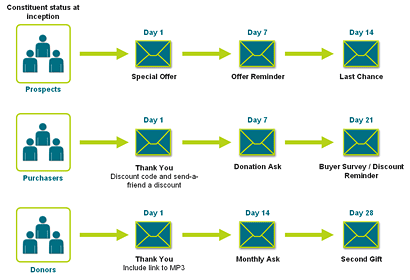Jul/Aug 2007
Relationship Pathways: A Holistic, Strategic Approach for Developing Constituents
by Vinay Bhagat, Founder and Chief Strategy Officer, Convio
The Internet represents an extremely powerful and cost effective relationship management tool. However, today most organizations practice one-size-fits-all communications. They send the same communiqués and solicitations to constituents, irrespective of their past involvement, their reason for first coming to the organization, or their interests. This approach made sense while organizations had small email files, basic online tools and very constrained Web resources. But as email files have expanded, many nonprofits are missing a great opportunity.
Nonprofits should adopt a strategic constituent relationship management approach — otherwise known as CRM — to managing online relationships. A CRM approach requires that nonprofits identify key constituent segments according to their current involvement or support levels; establish goals as to how they would like to see them progress; and define migration paths or "relationship pathways" along which they will try and direct constituents. Examples of "relationship pathways" or desired "conversion flows" are:
- Moving people visiting your Web site to subscribe to your e-communications;
- Moving e-newsletter subscribers to take some kind of action, such as participating in an advocacy campaign or making an online purchase;
- Moving advocates to become donors;
- Moving new or one-time donors to become repeat donors;
- Moving repeat donors to become monthly or sustaining donors;
- Moving repeat donors to solicit donations and other forms of support from friends, family and colleagues; and
- Moving appropriate long-term, repeat donors to consider a planned gift.
Clearly it is possible to create many unique segments and corresponding relationship pathways. The art is in identifying the most important ones that would benefit from unique treatment and that you can reasonably define and manage.
One of the "relationship segments" we have identified that requires unique treatment is new Web site registrants. Traditionally, new registrants receive a single welcome email (autoresponder) but are then added to the organization's general email communication. In our work with clients we have found that it's critical to engage and attempt to convert new constituents in their first 45-90 days on file while interest and open rates are highest. Instead of including them in the general email mix, we have realized strong results by sending them a unique series of welcome emails. In the email series, they are educated about resources on the Web site, encouraged to get more involved, and asked to make a contribution two to three times. If they make a contribution they exit the welcome series early. This email series and process can be automated using Convio's eCRM software. With this approach, we have found that clients have been able to convert about one percent of new registrants to donors within 60 days. This compares extremely favorably with a typical email acquisition response rate of 0.1-0.2 percent.
We have also worked with clients on relationship pathway efforts that stream people according to their reason for first coming to the organization. Figure 1 illustrates three concurrent pathways for a faith-based organization. In this example, prospects who are online subscribers who have not donated or bought a product are presented with a series of offers after joining the organization's email file. Purchasers are encouraged to become repeat purchasers and then asked to become donors. New donors are thanked and then encouraged to become monthly or at minimum repeat donors.

Fig. 1 - Relationship pathways based upon involvement level/inception
Organizations who have built email files in the thousands of constituents can benefit greatly from adopting a CRM-based approach to their online communication and conversion efforts. It is important to not "over-engineer" the approach and design an unmanageable number of segments and pathways. Start by picking one segment that you feel needs special attention.